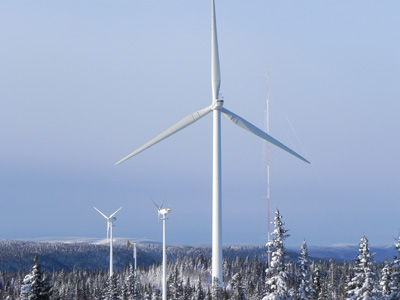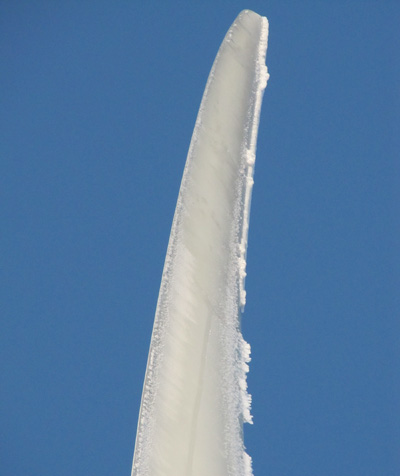Wind Site Considerations: In cold climate conditions
 With 59 gigawatts (GW) of capacity currently installed globally according to the “World Market Update 2012 Report,” wind energy projects in cold climates already occupy a significant market share. Moreover, of the 11.5 GW of wind power installed worldwide at sites that exhibit moderate to severe icing conditions, the report found that 66% are presently concentrated in North America, with 37% found in Canada and 29% in the United States. With an additional 50 GW expected by 2017, future business opportunities for this segment of the wind industry seem promising.
With 59 gigawatts (GW) of capacity currently installed globally according to the “World Market Update 2012 Report,” wind energy projects in cold climates already occupy a significant market share. Moreover, of the 11.5 GW of wind power installed worldwide at sites that exhibit moderate to severe icing conditions, the report found that 66% are presently concentrated in North America, with 37% found in Canada and 29% in the United States. With an additional 50 GW expected by 2017, future business opportunities for this segment of the wind industry seem promising.
Cold climate sites are increasingly targeted by project developers, as such areas often exhibit quality wind resources. According to the predictions for 2013 through to 2017, more than half (57%) of the eight gigawatts of global capacity expected to be installed in moderate to severe icing climates will be commissioned in Canada, along with another 17% in the US*. The timing couldn’t be better, considering the technological breakthroughs for such conditions are also rapidly advancing.
Cold climate research
But, what exactly is implied by “cold climate?” As defined by Task 19—Wind Energy in Cold Climates research collaboration under the International Energy Agency (IEA) Wind—cold climates are: “regions where icing events or periods with temperatures below the operational limits of standard wind turbines occur, which may impact project implementation, economics, and safety.”
The severity of the cold climate characteristics of a wind project site must be determined during the site assessment phase. In fact, Task 19 published a series of recommended practices for wind projects in such climates, and has introduced a method for classifying sites based on the frequency of icing events. As such, it’s critical to assess the characteristics of a potential site during the initial phases of wind project development to not only adequately measure the impact of cold climate (particularly icing), but also to quantify any associated production losses. Once this assessment has been completed, it’s easier for a developer to properly plan and pursue a project, and facilitate the project financing, while also reducing the risks incurred.
Several research and development projects related to wind energy in cold climates have been conducted, or are under way, in a number of countries. These studies aim to standardize methodologies and develop technologies to meet the challenges associated with forecasting and detecting ice, while assessing the severity of icing and its impact on infrastructures and health and safety, and finding solutions to minimize such impacts.
A measurement campaign focused on ice accretion on turbine blades and nacelle-based meteorological instrumentation, as well as on ice throw, has led to a classification of ice profiles that’s based on the ISO 12494 standard, including a distinction between rime and glaze. Using this methodology and the results of this study, a correlation can be established between the severity of an icing event and turbine production losses. This can also facilitate the development of icing detection algorithms, based on a computer vision system. Lastly, this study will help foster a better understanding of the IEA ice classification proposed by Task 19.
Long-term effects
 Although substantial research efforts are currently underway to develop technologies to reduce production losses stemming from ice accretion on turbine blades, the industry still has a limited understanding of the long-term effects of ice loads on the fatigue life of a turbine.
Although substantial research efforts are currently underway to develop technologies to reduce production losses stemming from ice accretion on turbine blades, the industry still has a limited understanding of the long-term effects of ice loads on the fatigue life of a turbine.
Results from another measurement campaign carried out at two sites, one in Canada and the other in Finland, concluded that icing can cause an aerodynamic imbalance of the rotor, leading to amplified tower oscillations and increased fatigue loads on the structure. The impact of cold climate on the load cases of a turbine will be considered in the next issue of the IEC 61400-1 standard on wind turbine design requirements.
The measurement campaigns described here have also allowed researchers to analyze, in a practical way, the configuration of met masts and their meteorological instruments. Recommendations have been made to optimize the instrumentation for met masts erected in cold climates conditions. Indeed, several factors must be taken into account prior to their installation, such as ice throw, ice accretion, extreme cold, challenges of performing maintenance on met masts in cold climates, tower design, data transfer, and power supply. The recommendations aim to aid wind project developers by optimizing the data available for each sensor used. In this manner, the quantity and quality of data obtained during the energy yield assessment of the site will improve.
Various research projects are being conducted to better understand the issues of cold climate on wind turbine operation. Ultimately, the results of these projects will have tangible impacts on the industry, including risk mitigation during site assessment, the development of ice protection systems, and the drafting of standards for turbine designs adapted to load cases associated with low temperature and icing climates.
All in all, site prospecting in cold climates, in accordance with industry best practices, will help developers reduce the uncertainties and financial risks of their project.
* Read more about the “World Market Update 2012 Report,” at www.navigantresearch.com/research/world-market-update-2012
The TechnoCentre éolien is a research and technology transfer centre that helps companies adapt their technology to withstand the northern climate, develop new products for the wind power industry, and integrate the power supply chain in Québec, Canada.
TechnoCentre éolien
www.eolien.qc.ca
Author: Matthew Wadham-Gagnon, Caroline Farley & Cédric Arbez
Volume: September/October 2013











